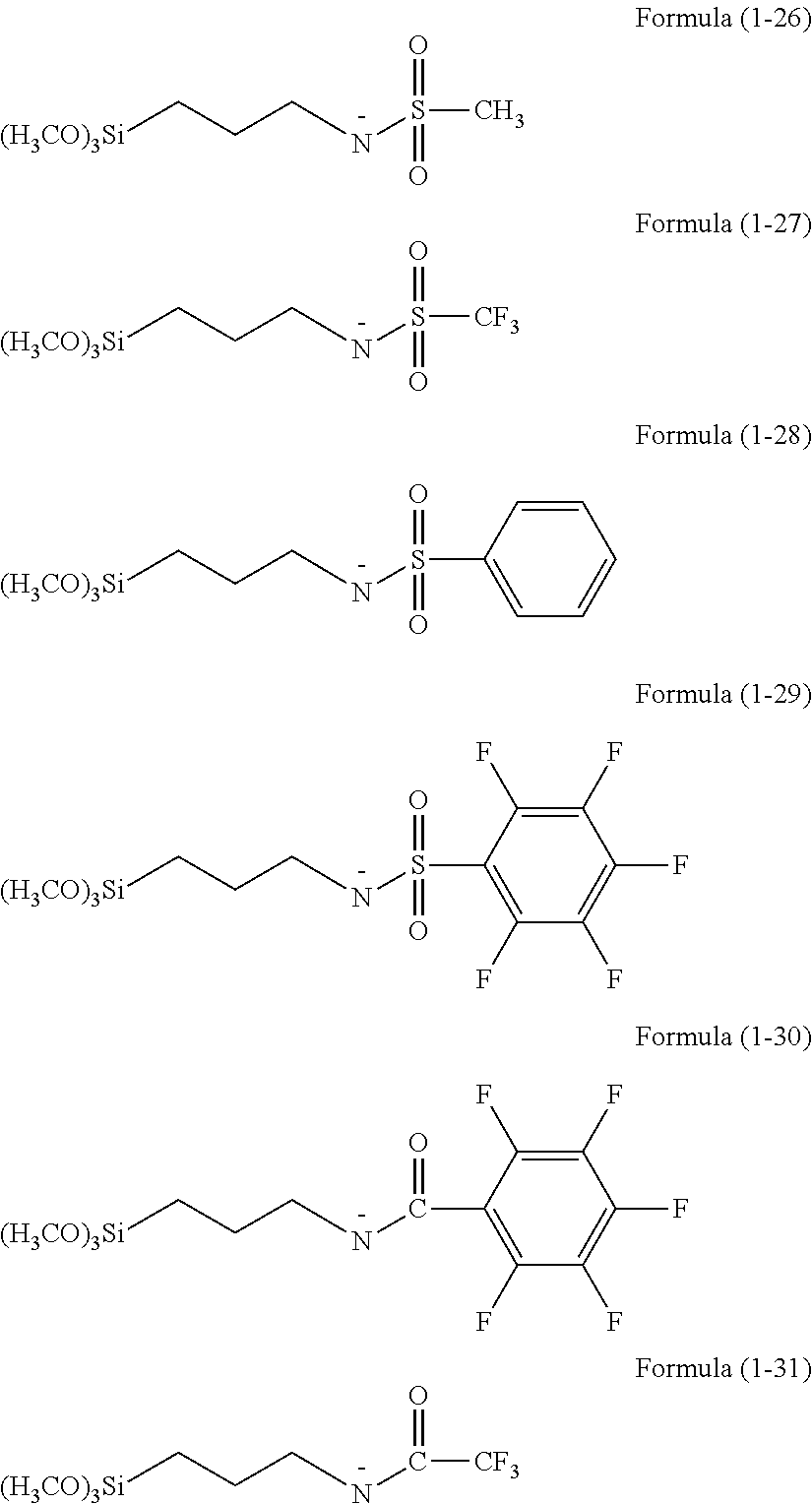Resist underlayer film forming composition containing silicon having anion group
- Summary
- Abstract
- Description
- Claims
- Application Information
AI Technical Summary
Benefits of technology
Problems solved by technology
Method used
Image
Examples
synthesis example 1
[0129]4.98 g of phenyltrimethoxysilane, 67.98 g of tetraethoxysilane, 26.89 g of methyltriethoxysilane, 0.15 g of trimethoxysilylpropyl succinic anhydride, and 150 g of acetone were charged into a 500 mL flask to be dissolved and the resultant mixed solution was warmed while stirring the mixed solution with a magnetic stirrer to reflux. Next, 33.06 g of a 0.01 M hydrochloric acid aqueous solution was added to the mixed solution. The reaction was carried out for 240 minutes and then the resultant reaction solution was cooled down to room temperature. Then, 200 g of propylene glycol monoethyl ether was added to the reaction solution, and ethanol, water and hydrochloric acid being reaction by-products were distilled off under reduced pressure to obtain a hydrolysis-condensation product. To the hydrolysis-condensation product, 0.097 g of ethylimidazole was added to obtain an ethylimidazolium carboxylic acid salt-containing Si polymer. The obtained polymer corresponded to a polymer havin...
synthesis example 2
[0131]4.98 g of phenyltrimethoxysilane, 67.98 g of tetraethoxysilane, 26.89 g of methyltriethoxysilane, 0.15 g of trimethoxysilylpropyl succinic anhydride, and 150 g of acetone were charged into a 500 mL flask to be dissolved and the resultant mixed solution was warmed while stirring the mixed solution with a magnetic stirrer to reflux. Next, 33.06 g of a 0.01 M hydrochloric acid aqueous solution was added to the mixed solution. The reaction was carried out for 240 minutes and then the resultant reaction solution was cooled down to room temperature. Then, 200 g of propylene glycol monoethyl ether was added to the reaction solution, and ethanol, water and hydrochloric acid being reaction by-products were distilled off under reduced pressure to obtain a hydrolysis-condensation product. To the hydrolysis-condensation product, 0.10 g of triethylamine was added to obtain a triethylammonium carboxylic acid salt-containing Si polymer. The obtained polymer corresponded to a polymer having f...
synthesis example 3
[0133]4.98 g of phenyltrimethoxysilane, 67.98 g of tetraethoxysilane, 26.89 g of methyltriethoxysilane, 0.15 g of trimethoxysilylpropyl succinic anhydride, and 150 g of acetone were charged into a 500 mL flask to be dissolved and the resultant mixed solution was warmed while stirring the mixed solution with a magnetic stirrer to reflux. Next, 33.06 g of a 0.01 M hydrochloric acid aqueous solution was added to the mixed solution. The reaction was carried out for 240 minutes and then the resultant reaction solution was cooled down to room temperature. Then, 200 g of propylene glycol monoethyl ether was added to the reaction solution, and ethanol, water and hydrochloric acid being reaction by-products were distilled off under reduced pressure to obtain a hydrolysis-condensation product. To the hydrolysis-condensation product, 0.080 g of pyridine was added to obtain a pyridinium carboxylic acid salt-containing Si polymer. The obtained polymer corresponded to a polymer having four types ...
PUM
| Property | Measurement | Unit |
|---|---|---|
| Area | aaaaa | aaaaa |
| Ratio | aaaaa | aaaaa |
| Hydrolysable | aaaaa | aaaaa |
Abstract
Description
Claims
Application Information
 Login to View More
Login to View More - R&D
- Intellectual Property
- Life Sciences
- Materials
- Tech Scout
- Unparalleled Data Quality
- Higher Quality Content
- 60% Fewer Hallucinations
Browse by: Latest US Patents, China's latest patents, Technical Efficacy Thesaurus, Application Domain, Technology Topic, Popular Technical Reports.
© 2025 PatSnap. All rights reserved.Legal|Privacy policy|Modern Slavery Act Transparency Statement|Sitemap|About US| Contact US: help@patsnap.com



